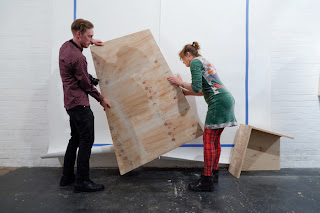Hours: Thursday - Sunday 12 - 5 pm May 3 -27 2012
Traces in a Landscape: On the Edge of Greta is the culmination of a collaborative project by two Sydney artists, Vivienne Dadour and Elizabeth Ashburn that extended from 2010 to 2012.
Vivienne
Dadour Stereoscopic Views series 2 #1 2012
Liz Ashburn Traces #1 2012, Watercolour on
board 36x 37.5 cm
This art project was
conceived as a archeological investigation of a site on the outskirts of the
town, Greta, in the Hunter Valley region of New South Wales. From 1939-49 it was
the site for the largest army training camp in Australia. Between 1949-1959, it
became known as the Greta Migrant Camp a venue for a massive immigration
program for those displaced by the conflict in Europe during the Second World
War. Both the involvement of Australian soldiers in international conflicts and
the great wave of resettlement of migrants remain significant events in
Australian history.
Dadour
and Ashburn engaged with examining the present landscape for the residue and
remnants of previous actions or occupancy through an active process of art
making related to what has survived. They responded individually and collaboratively
using photography, watercolour and drawing to express the presence/absence
dimension of this landscape. As the occupants of the Greta site were situated
on the edge of the town of Greta, Ashburn and Dadour are aware they also are on
the edge of the multiple histories of this site. Traces in a Landscape: On the Edge of Greta is a protest against
forgetting and aligns with the political sub-texts often found in the work of
these artists through their concern in revealing what may have been obliterated,
ignored, hidden or obscured.
One implication of their collaboration is
that by making aspects of this site accessible to others a reality implicit in
this regenerated landscape can now be shared.
www.viviennedadour.com; www.lizashburn.com
press release
Traces in a Landscape: On the Edge of Greta is part of Head On.
press release
Traces in a Landscape: On the Edge of Greta is part of Head On.






































